哲学之后的艺术
- 格式:docx
- 大小:15.39 KB
- 文档页数:2
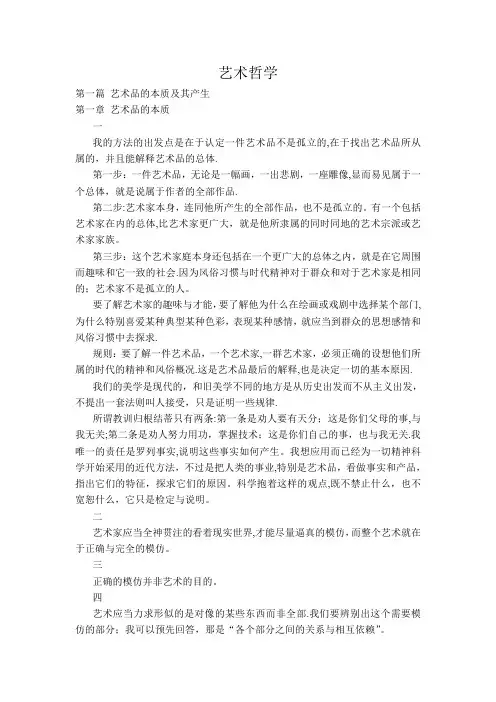
艺术哲学第一篇艺术品的本质及其产生第一章艺术品的本质一我的方法的出发点是在于认定一件艺术品不是孤立的,在于找出艺术品所从属的,并且能解释艺术品的总体.第一步:一件艺术品,无论是一幅画,一出悲剧,一座雕像,显而易见属于一个总体,就是说属于作者的全部作品.第二步:艺术家本身,连同他所产生的全部作品,也不是孤立的。
有一个包括艺术家在内的总体,比艺术家更广大,就是他所隶属的同时同地的艺术宗派或艺术家家族。
第三步:这个艺术家庭本身还包括在一个更广大的总体之内,就是在它周围而趣味和它一致的社会.因为风俗习惯与时代精神对于群众和对于艺术家是相同的;艺术家不是孤立的人。
要了解艺术家的趣味与才能,要了解他为什么在绘画或戏剧中选择某个部门,为什么特别喜爱某种典型某种色彩,表现某种感情,就应当到群众的思想感情和风俗习惯中去探求.规则:要了解一件艺术品,一个艺术家,一群艺术家,必须正确的设想他们所属的时代的精神和风俗概况.这是艺术品最后的解释,也是决定一切的基本原因.我们的美学是现代的,和旧美学不同的地方是从历史出发而不从主义出发,不提出一套法则叫人接受,只是证明一些规律.所谓教训归根结蒂只有两条:第一条是劝人要有天分;这是你们父母的事,与我无关;第二条是劝人努力用功,掌握技术;这是你们自己的事,也与我无关.我唯一的责任是罗列事实,说明这些事实如何产生。
我想应用而已经为一切精神科学开始采用的近代方法,不过是把人类的事业,特别是艺术品,看做事实和产品,指出它们的特征,探求它们的原因。
科学抱着这样的观点,既不禁止什么,也不宽恕什么,它只是检定与说明。
二艺术家应当全神贯注的看着现实世界,才能尽量逼真的模仿,而整个艺术就在于正确与完全的模仿。
三正确的模仿并非艺术的目的。
四艺术应当力求形似的是对像的某些东西而非全部.我们要辨别出这个需要模仿的部分;我可以预先回答,那是“各个部分之间的关系与相互依赖”。
我们在实物中感到兴趣而要求艺术家摘录和表现的,无非是实物内部外部的逻辑,换句话说,是事物的结构,组织与配合。
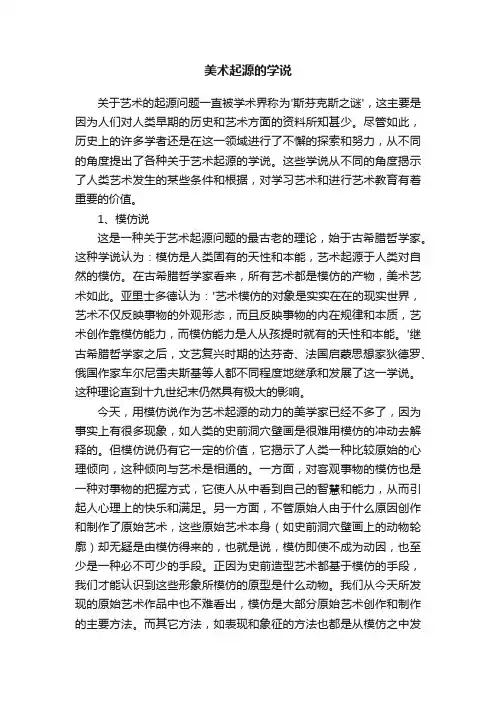
美术起源的学说关于艺术的起源问题一直被学术界称为'斯芬克斯之谜',这主要是因为人们对人类早期的历史和艺术方面的资料所知甚少。
尽管如此,历史上的许多学者还是在这一领域进行了不懈的探索和努力,从不同的角度提出了各种关于艺术起源的学说。
这些学说从不同的角度揭示了人类艺术发生的某些条件和根据,对学习艺术和进行艺术教育有着重要的价值。
1、模仿说这是一种关于艺术起源问题的最古老的理论,始于古希腊哲学家。
这种学说认为:模仿是人类固有的天性和本能,艺术起源于人类对自然的模仿。
在古希腊哲学家看来,所有艺术都是模仿的产物,美术艺术如此。
亚里士多德认为:'艺术模仿的对象是实实在在的现实世界,艺术不仅反映事物的外观形态,而且反映事物的内在规律和本质,艺术创作靠模仿能力,而模仿能力是人从孩提时就有的天性和本能。
'继古希腊哲学家之后,文艺复兴时期的达芬奇、法国启蒙思想家狄德罗、俄国作家车尔尼雪夫斯基等人都不同程度地继承和发展了这一学说。
这种理论直到十九世纪末仍然具有极大的影响。
今天,用模仿说作为艺术起源的动力的美学家已经不多了,因为事实上有很多现象,如人类的史前洞穴壁画是很难用模仿的冲动去解释的。
但模仿说仍有它一定的价值,它揭示了人类一种比较原始的心理倾向,这种倾向与艺术是相通的。
一方面,对客观事物的模仿也是一种对事物的把握方式,它使人从中看到自己的智慧和能力,从而引起人心理上的快乐和满足。
另一方面,不管原始人由于什么原因创作和制作了原始艺术,这些原始艺术本身(如史前洞穴壁画上的动物轮廓)却无疑是由模仿得来的,也就是说,模仿即使不成为动因,也至少是一种必不可少的手段。
正因为史前造型艺术都基于模仿的手段,我们才能认识到这些形象所模仿的原型是什么动物。
我们从今天所发现的原始艺术作品中也不难看出,模仿是大部分原始艺术创作和制作的主要方法。
而其它方法,如表现和象征的方法也都是从模仿之中发展演变而来的。
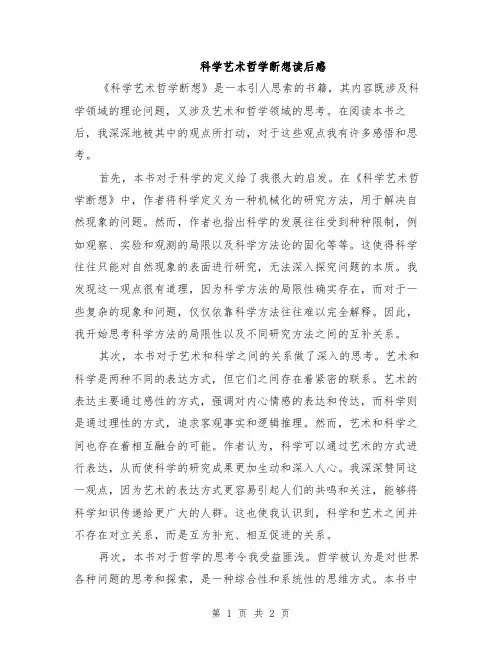
科学艺术哲学断想读后感《科学艺术哲学断想》是一本引人思索的书籍,其内容既涉及科学领域的理论问题,又涉及艺术和哲学领域的思考。
在阅读本书之后,我深深地被其中的观点所打动,对于这些观点我有许多感悟和思考。
首先,本书对于科学的定义给了我很大的启发。
在《科学艺术哲学断想》中,作者将科学定义为一种机械化的研究方法,用于解决自然现象的问题。
然而,作者也指出科学的发展往往受到种种限制,例如观察、实验和观测的局限以及科学方法论的固化等等。
这使得科学往往只能对自然现象的表面进行研究,无法深入探究问题的本质。
我发现这一观点很有道理,因为科学方法的局限性确实存在,而对于一些复杂的现象和问题,仅仅依靠科学方法往往难以完全解释。
因此,我开始思考科学方法的局限性以及不同研究方法之间的互补关系。
其次,本书对于艺术和科学之间的关系做了深入的思考。
艺术和科学是两种不同的表达方式,但它们之间存在着紧密的联系。
艺术的表达主要通过感性的方式,强调对内心情感的表达和传达,而科学则是通过理性的方式,追求客观事实和逻辑推理。
然而,艺术和科学之间也存在着相互融合的可能。
作者认为,科学可以通过艺术的方式进行表达,从而使科学的研究成果更加生动和深入人心。
我深深赞同这一观点,因为艺术的表达方式更容易引起人们的共鸣和关注,能够将科学知识传递给更广大的人群。
这也使我认识到,科学和艺术之间并不存在对立关系,而是互为补充、相互促进的关系。
再次,本书对于哲学的思考令我受益匪浅。
哲学被认为是对世界各种问题的思考和探索,是一种综合性和系统性的思维方式。
本书中提到的哲学问题很多,例如存在与无存在、物质与精神、人的自由意志等等。
这些问题并没有确切的答案,但正是人们对这些问题的思考和探索,推动了人类文明的发展。
通过阅读本书,我对哲学的意义有了更深的理解,也开始逐渐对自己的世界观和人生观进行反思。
最后,本书还深入探讨了科学、艺术和哲学的社会作用。
作者认为,科学不仅仅是为了追求真理,更是为了改造和改善人类社会。
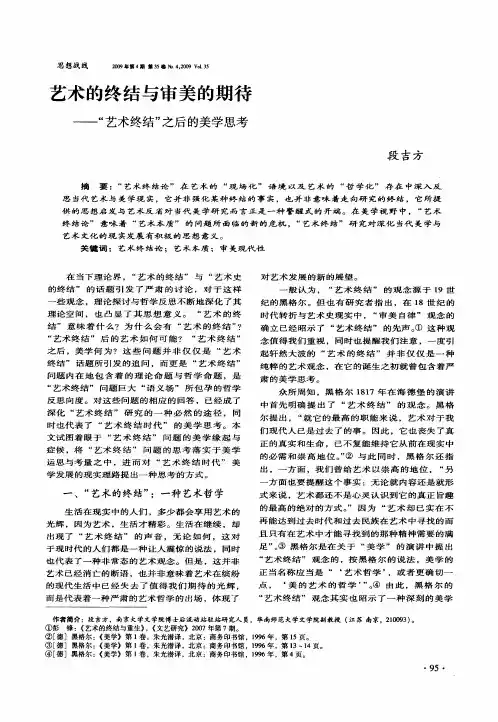
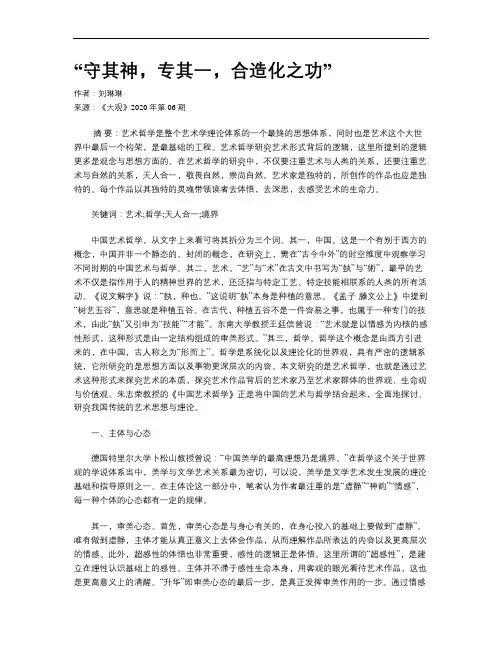
“守其神,专其一,合造化之功”作者:刘琳琳来源:《大观》2020年第06期摘要:艺术哲学是整个艺术学理论体系的一个最终的思想体系,同时也是艺术这个大世界中最后一个构架,是最基础的工程。
艺术哲学研究艺术形式背后的逻辑,这里所提到的逻辑更多是观念与思想方面的。
在艺术哲学的研究中,不仅要注重艺术与人类的关系,还要注重艺术与自然的关系,天人合一,敬畏自然,崇尚自然。
艺术家是独特的,所创作的作品也应是独特的。
每个作品以其独特的灵魂带领读者去体悟,去深思,去感受艺术的生命力。
关键词:艺术;哲学;天人合一;境界中国艺术哲学,从文字上来看可将其拆分为三个词。
其一,中国。
这是一个有别于西方的概念,中国并非一个静态的、封闭的概念,在研究上,需在“古今中外”的时空维度中观察学习不同时期的中国艺术与哲学。
其二,艺术。
“艺”与“术”在古文中书写为“埶”与“術”,最早的艺术不仅是指作用于人的精神世界的艺术,还泛指与特定工艺、特定技能相联系的人类的所有活动。
《说文解字》说:“埶,种也。
”这说明“埶”本身是种植的意思。
《孟子·滕文公上》中提到“树艺五谷”,意思就是种植五谷。
在古代,种植五谷不是一件容易之事,也属于一种专门的技术,由此“埶”又引申为“技能”“才能”。
东南大学教授王廷信曾说:“艺术就是以情感为内核的感性形式,这种形式是由一定结构组成的审美形式。
”其三,哲学。
哲学这个概念是由西方引进来的,在中国,古人称之为“形而上”。
哲学是系统化以及理论化的世界观,具有严密的逻辑系统,它所研究的是思想方面以及事物更深层次的内容。
本文研究的是艺术哲学,也就是通过艺术这种形式来探究艺术的本质,探究艺术作品背后的艺术家乃至艺术家群体的世界观、生命观与价值观。
朱志荣教授的《中国艺术哲学》正是将中国的艺术与哲学结合起来,全面地探讨、研究我国传统的艺术思想与理论。
一、主体与心态德国特里尔大学卜松山教授曾说:“中国美学的最高理想乃是境界。
![[整理版]西方美学史(摘要)](https://uimg.taocdn.com/1e383bc748649b6648d7c1c708a1284ac8500584.webp)
西方美学史第一部分古希腊罗马哲学第一章西方美学的缘起西方美学的直接源头是在古希腊。
.观点1:美学思想最早包含在艺术之中。
(塔塔凯维奇)观点2:人类的审美意识产生于原始宗教向哲学的过渡阶段。
(鲍桑奎)观点3:哲学孕育了美学。
(吉尔伯特和库恩)观点4:美学问题只能出现于哲学问题之后。
(克罗齐)(作者赞同)第二章前苏格拉底美学一毕达哥拉斯学派1和谐(harmony)是宇宙的本质特征。
神秘的和谐现象是由比例、尺度和数造成的,而和谐本身则是以各个组成部分的数学关系为基础的。
和谐是一种宇宙内在的规律和本质,音乐通过声音与音调表现了这种和谐,而哲学(数学被包括在哲学之中)则是对事物之间和谐关系的思索,美因此成为宇宙和人的最终目的。
2音乐可以净化(cathartic)灵魂。
从表面上来看,他们以音乐和哲学为修养手段,用音乐来净化人的灵魂,似乎与奥尔弗斯教派的酗酒、癫狂的神秘体验不同,但是,实质上,平静的哲学与和谐的音乐亦可产生精神上的迷狂感。
在这种迷狂中,灵魂亦能够摆脱肉体,进入神秘境界。
————这种思想也是希腊非理性精神的一个来源。
3具体事物和艺术作品中的和谐的构成。
最聪明的事物是数,最有力量的事物是知识,最美好的事物是幸福,最优美的事物是和谐。
与数相关的和谐原则是西方从古希腊到19世纪全部古典艺术的理想。
二赫拉克利特1和谐产生于对立和斗争。
“看不见的和谐(hidden harmony)比看得见的和谐更好。
”艺术是对自然的模仿,实质上是对于自然中一种和谐的模仿,因而艺术家应该具有一种对自然界内在和谐的把握和认识。
2美具有相对性。
美学家们总是不断的讨论美的概念与具体的美的事物之间的关系问题,这里面实质上就是美的永恒性与相对性的问题,也就是哲学上的概念的相对性与真理的具体性问题。
三德谟克利特1模仿说。
艺术是模仿的观点,是古希腊人们的普遍看法。
德认为艺术起源于模仿,同时也指出了艺术的模仿性质,提出了一种艺术本体论的看法(包括艺术的创作论)。
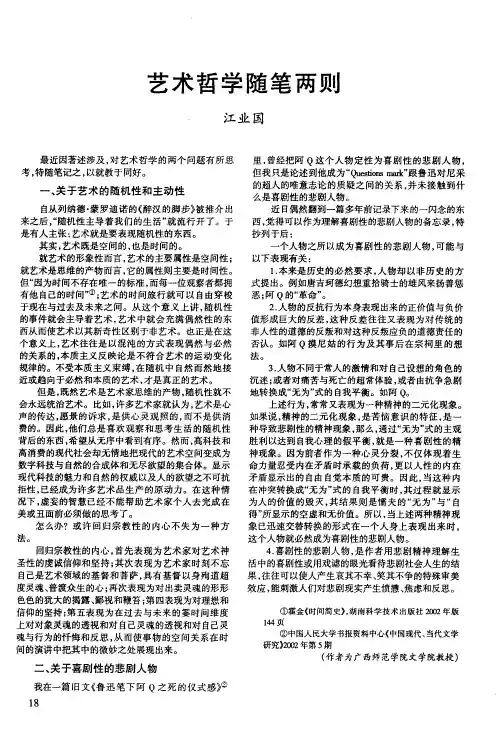
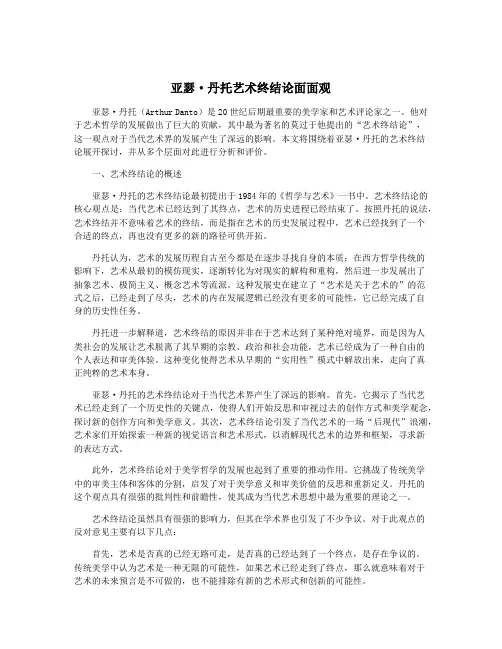
亚瑟·丹托艺术终结论面面观亚瑟·丹托(Arthur Danto)是20世纪后期最重要的美学家和艺术评论家之一。
他对于艺术哲学的发展做出了巨大的贡献,其中最为著名的莫过于他提出的“艺术终结论”,这一观点对于当代艺术界的发展产生了深远的影响。
本文将围绕着亚瑟·丹托的艺术终结论展开探讨,并从多个层面对此进行分析和评价。
一、艺术终结论的概述亚瑟·丹托的艺术终结论最初提出于1984年的《哲学与艺术》一书中。
艺术终结论的核心观点是:当代艺术已经达到了其终点,艺术的历史进程已经结束了。
按照丹托的说法,艺术终结并不意味着艺术的终结,而是指在艺术的历史发展过程中,艺术已经找到了一个合适的终点,再也没有更多的新的路径可供开拓。
丹托认为,艺术的发展历程自古至今都是在逐步寻找自身的本质:在西方哲学传统的影响下,艺术从最初的模仿现实,逐渐转化为对现实的解构和重构,然后进一步发展出了抽象艺术、极简主义、概念艺术等流派。
这种发展史在建立了“艺术是关于艺术的”的范式之后,已经走到了尽头,艺术的内在发展逻辑已经没有更多的可能性,它已经完成了自身的历史性任务。
丹托进一步解释道,艺术终结的原因并非在于艺术达到了某种绝对境界,而是因为人类社会的发展让艺术脱离了其早期的宗教、政治和社会功能,艺术已经成为了一种自由的个人表达和审美体验。
这种变化使得艺术从早期的“实用性”模式中解放出来,走向了真正纯粹的艺术本身。
亚瑟·丹托的艺术终结论对于当代艺术界产生了深远的影响。
首先,它揭示了当代艺术已经走到了一个历史性的关键点,使得人们开始反思和审视过去的创作方式和美学观念,探讨新的创作方向和美学意义。
其次,艺术终结论引发了当代艺术的一场“后现代”浪潮,艺术家们开始探索一种新的视觉语言和艺术形式,以消解现代艺术的边界和框架,寻求新的表达方式。
此外,艺术终结论对于美学哲学的发展也起到了重要的推动作用。
它挑战了传统美学中的审美主体和客体的分割,启发了对于美学意义和审美价值的反思和重新定义。
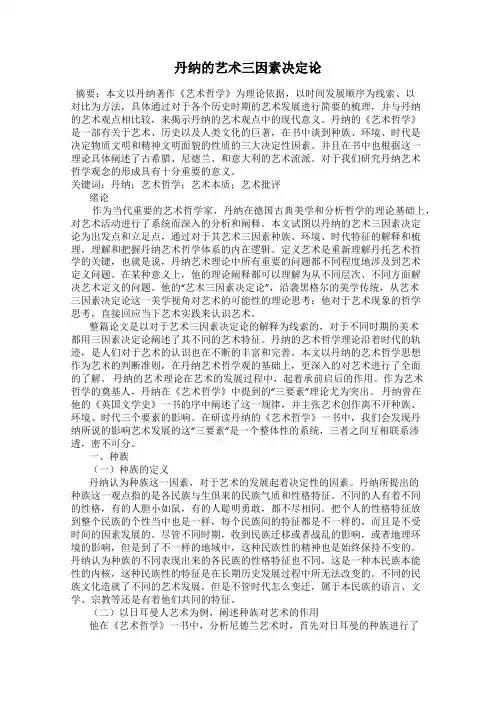
丹纳的艺术三因素决定论摘要:本文以丹纳著作《艺术哲学》为理论依据,以时间发展顺序为线索、以对比为方法,具体通过对于各个历史时期的艺术发展进行简要的梳理,并与丹纳的艺术观点相比较,来揭示丹纳的艺术观点中的现代意义。
丹纳的《艺术哲学》是一部有关于艺术、历史以及人类文化的巨著,在书中谈到种族、环境、时代是决定物质文明和精神文明面貌的性质的三大决定性因素。
并且在书中也根据这一理论具体阐述了古希腊、尼德兰、和意大利的艺术流派。
对于我们研究丹纳艺术哲学观念的形成具有十分重要的意义。
关键词:丹纳;艺术哲学;艺术本质;艺术批评绪论作为当代重要的艺术哲学家,丹纳在德国古典美学和分析哲学的理论基础上,对艺术活动进行了系统而深入的分析和阐释。
本文试图以丹纳的艺术三因素决定论为出发点和立足点,通过对于其艺术三因素种族、环境、时代特征的解释和梳理,理解和把握丹纳艺术哲学体系的内在逻辑。
定义艺术是重新理解丹托艺术哲学的关键,也就是说,丹纳艺术理论中所有重要的问题都不同程度地涉及到艺术定义问题。
在某种意义上,他的理论阐释都可以理解为从不同层次、不同方面解决艺术定义的问题。
他的“艺术三因素决定论”,沿袭黑格尔的美学传统,从艺术三因素决定论这一美学视角对艺术的可能性的理论思考;他对于艺术现象的哲学思考,直接回应当下艺术实践来认识艺术。
整篇论文是以对于艺术三因素决定论的解释为线索的,对于不同时期的美术都用三因素决定论阐述了其不同的艺术特征。
丹纳的艺术哲学理论沿着时代的轨迹,是人们对于艺术的认识也在不断的丰富和完善。
本文以丹纳的艺术哲学思想作为艺术的判断准则,在丹纳艺术哲学观的基础上,更深入的对艺术进行了全面的了解。
丹纳的艺术理论在艺术的发展过程中,起着承前启后的作用。
作为艺术哲学的奠基人,丹纳在《艺术哲学》中提到的“三要素”理论尤为突出。
丹纳曾在他的《英国文学史》一书的序中阐述了这一规律,并主张艺术创作离不开种族、环境、时代三个要素的影响。
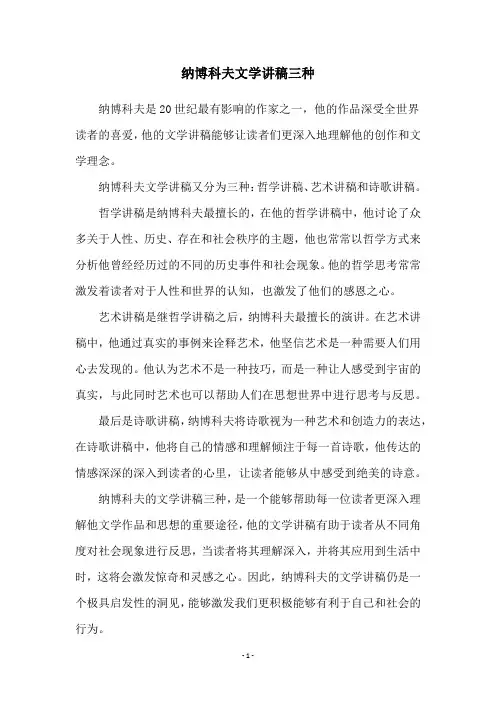
纳博科夫文学讲稿三种
纳博科夫是20世纪最有影响的作家之一,他的作品深受全世界
读者的喜爱,他的文学讲稿能够让读者们更深入地理解他的创作和文学理念。
纳博科夫文学讲稿又分为三种:哲学讲稿、艺术讲稿和诗歌讲稿。
哲学讲稿是纳博科夫最擅长的,在他的哲学讲稿中,他讨论了众多关于人性、历史、存在和社会秩序的主题,他也常常以哲学方式来分析他曾经经历过的不同的历史事件和社会现象。
他的哲学思考常常激发着读者对于人性和世界的认知,也激发了他们的感恩之心。
艺术讲稿是继哲学讲稿之后,纳博科夫最擅长的演讲。
在艺术讲稿中,他通过真实的事例来诠释艺术,他坚信艺术是一种需要人们用心去发现的。
他认为艺术不是一种技巧,而是一种让人感受到宇宙的真实,与此同时艺术也可以帮助人们在思想世界中进行思考与反思。
最后是诗歌讲稿,纳博科夫将诗歌视为一种艺术和创造力的表达,在诗歌讲稿中,他将自己的情感和理解倾注于每一首诗歌,他传达的情感深深的深入到读者的心里,让读者能够从中感受到绝美的诗意。
纳博科夫的文学讲稿三种,是一个能够帮助每一位读者更深入理解他文学作品和思想的重要途径,他的文学讲稿有助于读者从不同角度对社会现象进行反思,当读者将其理解深入,并将其应用到生活中时,这将会激发惊奇和灵感之心。
因此,纳博科夫的文学讲稿仍是一个极具启发性的洞见,能够激发我们更积极能够有利于自己和社会的行为。
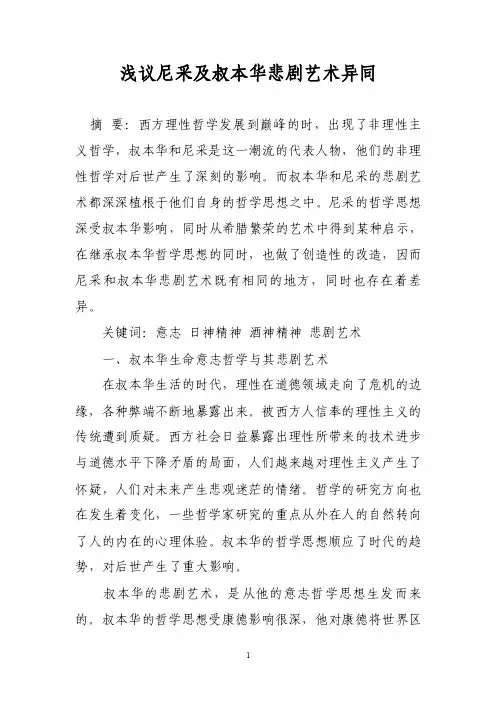
浅议尼采及叔本华悲剧艺术异同摘要:西方理性哲学发展到巅峰的时,出现了非理性主义哲学,叔本华和尼采是这一潮流的代表人物,他们的非理性哲学对后世产生了深刻的影响。
而叔本华和尼采的悲剧艺术都深深植根于他们自身的哲学思想之中。
尼采的哲学思想深受叔本华影响,同时从希腊繁荣的艺术中得到某种启示,在继承叔本华哲学思想的同时,也做了创造性的改造,因而尼采和叔本华悲剧艺术既有相同的地方,同时也存在着差异。
关键词:意志日神精神酒神精神悲剧艺术一、叔本华生命意志哲学与其悲剧艺术在叔本华生活的时代,理性在道德领域走向了危机的边缘,各种弊端不断地暴露出来。
被西方人信奉的理性主义的传统遭到质疑。
西方社会日益暴露出理性所带来的技术进步与道德水平下降矛盾的局面,人们越来越对理性主义产生了怀疑,人们对未来产生悲观迷茫的情绪。
哲学的研究方向也在发生着变化,一些哲学家研究的重点从外在人的自然转向了人的内在的心理体验。
叔本华的哲学思想顺应了时代的趋势,对后世产生了重大影响。
叔本华的悲剧艺术,是从他的意志哲学思想生发而来的。
叔本华的哲学思想受康德影响很深,他对康德将世界区分为“物自体”和”现象”表示高度赞扬,但是他又不同意康德所说的“物自体”是不可知的,认为人们可以明确地认识这个“物自体”,而这个“物自体”在叔本华看来就是意志。
为此,叔本华提出了两个命题:一个是“世界是我的表象”[1];一个是“世界是我的意志”[2]。
“世界是我的表象”这个命题意思是说,人所生活的这个世界,并不是独立于人而存在的世界,这个世界只有在与人这个主体相关联,被人们所认识时,才有意义,是作为表象而存在。
“世界是我的意志”,是说世界的本质是意志。
宇宙中的一切都是依赖人这个主体而存在,因而是表象世界,其背后作为本质而存在的是意志世界。
作为世界的本质意志在叔本华看来,是一种“不能遏止的盲目冲动”,是一种永远都不能得到满足的欲望。
欲望、冲动是没有止境的,一种欲望满足了,相继的另一种欲望却产生了。
接受美学的发展历程
美学是研究美的本质、产生、表现和评价的学科,其发展历程可以追溯到古希腊哲学家亚里士多德。
亚里士多德在其著作《诗学》中,首次提出了美的概念,并将其与艺术、文学联系起来。
在亚里士多德之后,欧洲文艺复兴时期的文学家、艺术家们开始重视形式美,强调艺术作品的审美价值。
这一时期的美学家以德国哲学家康德和英国哲学家休谟为代表,他们强调美学经验的主观性和相对性,认为美是由观察者自身的情感和感受所决定的。
19世纪末,法国哲学家尼采提出了美学的“超验主义”思想,
认为艺术是超越现实世界的一种表达,艺术家是“超人”,具有超越
常人的能力和创造力。
这一时期的美学家强调艺术的自由和创造性,对“大众艺术”持批评态度。
20世纪初,德国哲学家海德格尔提出了“存在美学”思想,认
为美是存在的表达,是人类存在的一种特殊状态。
这一时期的美学家强调人类存在的意义和价值,在这种意义上重新审视艺术和美的本质。
后现代主义时期,美学开始关注身体、感官和情感等主观因素,认为美是与身体和情感紧密相关的经验。
同时,美学也开始反思传统美学的主体/客体二元对立,探索多元文化以及文化多样性对美学的
影响。
总的来说,美学的发展历程是一个不断寻找和探索美的本质和价值的过程,反映了人类对美的理解和认识的不断深入和丰富。
- 1 -。
艺术起源理论答案:关于艺术起源的几种重要观点:1.艺术起源于“模仿”在关于艺术起源问题的理论探索中,“模仿说”是最古老的一种说法。
古希腊哲学家德谟克利特认为艺术是对自然的“模仿”。
在他之后的古希腊哲学家亚里士多德更进一步认为模仿是人的本能,他指出所有的文艺都是“模仿”。
不管是何种样式和种类的艺术。
亚里士多德强调,所有的艺术都起源于对自然界和社会现实的模仿。
2.艺术起源于“游戏”艺术起源于“游戏”这一说法主要是由18世纪德国哲学家席勒和19世纪英国哲学家斯宾塞提出来的。
后来的艺术史家曾把艺术起源的这种说法称之为“席勒﹣斯宾塞理论”。
3.艺术起源于“表现”系统地以理论方式提出“艺术起源于表现”这一说法的应首推意大利美学家克罗齐,他的美学思想核心是“直觉即表现”。
克罗齐认为艺术的本质是直觉,直觉的来源是情感,直觉即表现,因而,艺术归根结底是情感的表现。
克罗齐强调艺术既不是功利的活动,也不是道德的活动,艺术甚至也不能分类,一切艺术无非都是情感的表现而已。
4.艺术起源于“巫术”此学说的代表人物是英国著名人类学家爱德华·泰勒。
他在《原始文化》一书中,最早提出艺术起源于“巫术”的理论主张。
他认为,原始人思维的方式同现代人有很大的不同,对原始人来说,周围的世界异常陌生和神秘,令人敬畏。
英国著名人类学家弗雷泽认为原始部落的一切风俗、仪式和信仰,都起源于交感巫术。
5.艺术起源于“劳动”俄国的普列汉诺夫在1900年完成了专著《没有地址的信》,系统地论述了艺术的起源及其发展问题,并且得出了艺术发生于劳动的观点。
从艺术发生学的观点来看生产劳动显然是艺术起源的根本原因。
但是,艺术起源又是个十分复杂的问题,它很可能是多因的,而并非单因的,是多元的,而不是单一的。
6.“多元决定论”在艺术起源这个漫长的历史过程中,原始人类模仿自然的本能(模仿说)、表现情感的需要(表现说)、游戏的需要(游戏说)渗透其中,尤其是对于原始人类来讲更为重要的原始巫术(巫术说)与原始生产劳动(劳动说),更是在其中发挥了决定性的作用。
So any branch of philosophy which dealt with ‘beauty’ and thus, taste, was
inevitably duty bound to discuss art as well. Out of this ‘habit’ grew the notion
that there was a conceptual connection between art and aesthetics, which is
not true.
因此,凡是涉及“美”以及趣味的任何哲学分支都不可避免地要讨论艺术。这种
“习惯”滋生出了这样一种观念,即艺术与美学之间具有一种概念上的联系,但
这并不是事实。
When objects are presented within the context of art (and until recently
objects always have been used ) they are as eligible for aesthetic
consideration as are any objects in the world, and an aesthetic consideration
of an objects existing in the realm of art means that the object’s existence or
functioning in an art context is irrelevant to the aesthetic judgement.
当客体被陈示于艺术语境中时(直到现在客体仍然被利用),它们就与世界中的
其它事物一样适合于审美观照,而艺术领域中存在的对客体的审美观照意味着
客体在艺术语境中的存在或作用与审美判断之间没有任何关系。
Exactly why they don’t comment on the conceptual element in works of art is
precisely because formalist art by virtue its resemblance to earlier works of
art.
他们对艺术作品中的观念因素不作评论的根本原因,恰恰就在于形式主义艺术
所以成为艺术不过是因为它貌似于以往的艺术作品。
But such an a priori concept of the nature of art ( as separate from analytically
framed art propositions or ‘work’ which I will discuss later ) makes it, indeed,
a priori: impossible to question the nature of art . And this questioning of the
nature of art is a very important concept in understanding the function of art.
艺术本质的这样一种先验的概念(不同于分析性结构的艺术命题或“作品” ,容下
文讨论),实际上使之成为一种先验的臆测:即不可能追问艺术的本质。这种对
艺术本质的追问,是理解艺术作用的十分重要的概念。
Works of art are analytic propositions, That is, if viewed within their context-as
art- they provide no information what-so-ever about any matter of fact. A work
of art is a tautology in that it is a presentation of the artist’s intention, that is,
he is saying that a particular work of art is art, which means, is a definition of
art. Thus, that it is art is true a priori ( which is what Judd means when he
states that “if someone calls it art, it’s art” ).
艺术作品是分析的命题。也就是说,如果艺术作品在自身的语境中被作为艺术
加以审视,那它们就不会提供关于事实的任何信息。艺术作品是一种语义重复,
因为它是艺术家意图的一种陈现,也就是说,艺术家是在说那件特殊的艺术作
品是艺术,意指是对艺术的一种界定。因此,这是艺术的说法就是一种真正的
先验存在(贾德说“如果有人称之为艺术,那就是艺术”时,就是这个意思)
To repeat, what art has in common with logic and mathematics is that it is a
tautology, i.e., the ‘art idea’ ( or ‘work’ ) and art are the same and can be
appreciated as art without going outside the context of art for verification.
艺术与逻辑和数学的共同之处,就在于它是一种语义重复,即是说,“艺术思想”
(或“作品”)和艺术是同一回事。它可以作为艺术被人欣赏而无需在艺术语境之外
求得证实。
Thus, as Ayer has stated:“There are no absolutely certain empirical
propositions. It is only tautologies that are certain. Empirical questions are one
and all hypotheses, which may be confirmed or discredited in actual sense-
experience. And the propositions in which we record the observations that
verify these hypotheses are themselves hypotheses which are subject to the
test of further sense-experience. Thus there is no final proposition. ”
因此,正如艾尔所说: 不存在什么绝对肯定的经验命题。只有语义重复是肯定
的。经验问题是彻头彻尾的假设,它在实际的知觉经验中可以被证实也可以被
怀疑。我们记录用来验证这些假设的观察方法时所采用的命题,本身就是假
设.它还要受到进一步的知觉经验的验证。所以并不存在最后的命题.
Forms of art that can be considered synthetic propositions are verifiable by
the world, that is to say, to understand these propositions one must leave the
tautological-like framework of art and consider ‘outside’ information, But to
consider it as art it is necessary to ignore this same outside information,
because outside information ( experiential qualities, to note ) has its own
intrinsic worth. And to comprehend this worth ones does not need a state of
‘art condition’.
因为艺术的形式可以被视为综合的命题,它要得到天地万物的验证,也就是说,
要理解这些命题,就必须离开貌似语义重复的艺术框架而考虑“外在的”信息。
但是,要将它视为艺术,就有必要无视这种外在的信息,因为外在的信息(注意,
这里指的是经验的特性)有它自己内在的价值。要理解这种价值,并不需要一种
“艺术状态”的状态。
Art indeed exists for its own sake.
艺术实际上是为自己而存在。